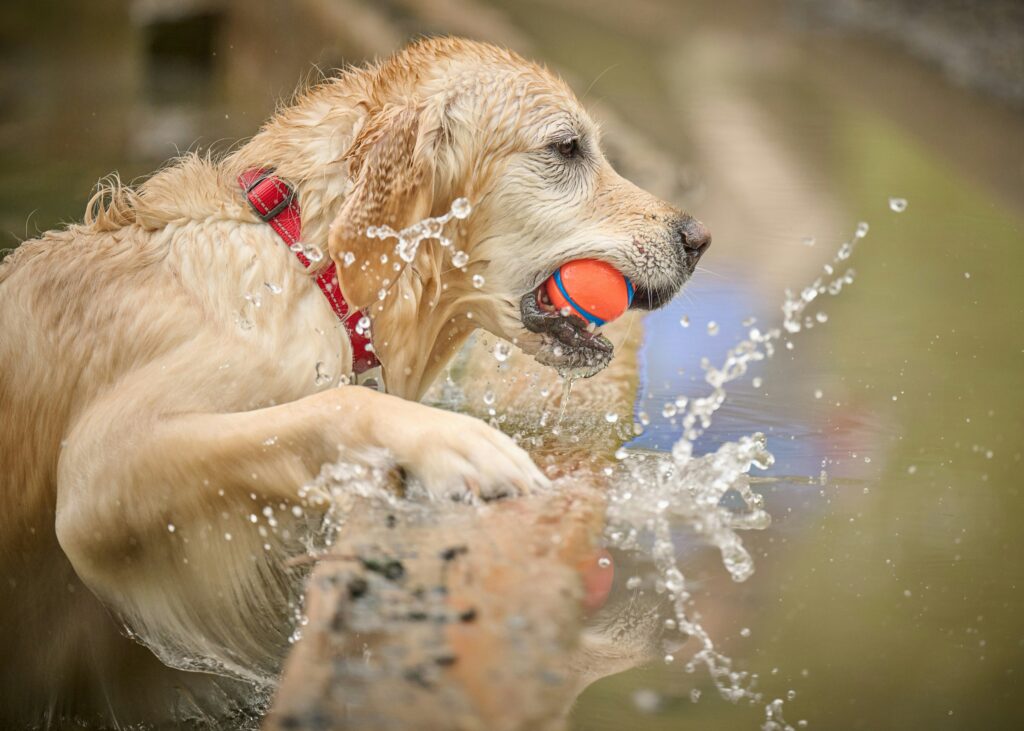Enrichment is designed to stimulate a dog’s mind and senses, providing mental and physical challenges that mimic natural behaviours. Enrichment activities might include puzzle toys, scent games, food-dispensing toys, obstacle courses, or sensory experiences like new smells or textures. Enrichment helps to reduce boredom, prevent destructive behaviour, and improve a dog’s overall well-being by keeping them engaged and mentally stimulated.
Play is typically focused on physical activity and social interaction. It allows dogs to burn off energy, bond with their owners or other dogs, and practice natural behaviours like chasing, tugging, and fetching. Common play activities include fetch, tug-of-war, playing with toys, or social play with other dogs. Play helps to build physical strength, agility, and social skills, and it provides an outlet for excess energy. It also strengthens the bond between the dog and its owner.
What’s the difference between Enrichment and play?
Enrichment is more about mental stimulation and problem-solving, while play is primarily about physical activity and social interaction. The goal of enrichment is to challenge a dog’s mind and satisfy natural instincts, while play is about exercise, fun, and bonding. Enrichment can be more low-key and focused, while play tends to be more energetic and physically demanding.
Both enrichment and play are important for a dog’s overall well-being, and incorporating a balance of both in their daily routine can lead to a happier, healthier pet.
Using Breed-Specific Activities to Benefit Dogs:
Different dog breeds were historically bred for specific tasks and jobs, such as herding, hunting, retrieving, or guarding. Engaging dogs in activities that tap into these natural instincts and breed-specific traits can provide them with a more fulfilling and enriched life.
Here’s how breed-specific activities can benefit your dog:
Border Collies, Australian Shepherds have a strong instinct to control and move animals. These dogs may enjoy herding trials, agility courses, or games where they “herd” balls or even toys. Engaging these dogs in tasks that involve movement and direction satisfies their herding instinct and helps prevent boredom and destructive behaviour.
Beagles and Bloodhounds have a strong sense of smell and a natural ability to track scents. Scent work or nose games, where dogs follow trails or search for hidden treats or toys will stimulate their natural tracking ability, providing mental stimulation while satisfying their drive to follow scents.
Golden Retrievers, Labrador Retrievers were bred for retrieving game, they have a strong fetching instinct. Playing fetch, dock diving, or retrieving specific items (like toys or balls) tap into their natural desire to retrieve, giving them both physical exercise and a mental challenge.

Jack Russell and West Highland Terriers have a strong prey drive and were bred for digging and hunting vermin. Earthdog trials, digging boxes filled with sand or toys, or games where they can “hunt” for objects can satisfy their prey drive and prevent them from becoming restless or frustrated.
Rottweilers and German Shepherds are strong, intelligent, and often used for guarding or protection. Protection sports, obedience training, or weight-pulling exercises will engage their strength and intelligence through structured activities to help them stay balanced, well-exercised, and mentally stimulated.
Poodles are Intelligent, agile, originally bred as water retrievers. Engaging their retrieving instinct by playing fetch in water or on land, agility training or advanced trick training can provide both mental and physical stimulation, helping prevent boredom and anxiety in such smart breeds.
Staffordshire Bull Terriers are muscular, strong, energetic, and people-oriented dogs. Playing tug of war utilises their strength in a controlled, engaging way while weight pulling and resistance training challenges their muscles while keeping them fit. Games like hide-and-seek or fetch provide both exercise and bonding. Physical activities help burn off energy, while interactive games strengthen their bond with humans and satisfy their need for affection.
Regardless of breed, all dogs benefit from enrichment activities. By understanding and incorporating breed-specific activities along with general enrichment strategies, dog owners can meet their dog’s unique needs and ensure that their dog leads a happy, healthy, and mentally fulfilled life.
Every dog is unique, with their own preferences, so the key to successful enrichment is ensuring that the dog genuinely enjoys and finds value in the activity.
Here is a short video of my staffie Jayda enjoying an enrichment session. Jayda is highly food motivated and like many Staffordshire Bull Terriers loves hide-and-seek games.